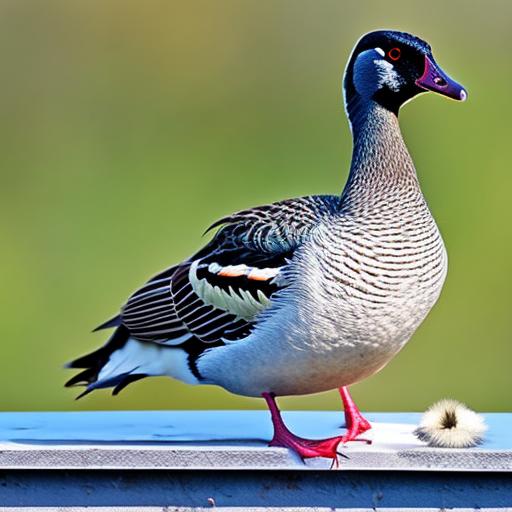Geese on roofs may seem like an unusual problem, but it is one that can cause significant damage and health risks if not addressed. Geese are attracted to roofs for a variety of reasons, including the height and safety they provide. In this article, we will explore why geese are attracted to roofs, the risks they pose, and various methods for keeping them away.
Key Takeaways
- Geese are attracted to roofs because they provide a safe and elevated nesting site.
- Geese on your roof can cause damage to shingles, gutters, and other roofing materials.
- Physical deterrents like netting and spikes can be effective in keeping geese off your roof.
- Scare tactics like decoys and noise makers can also be used to deter geese.
- Natural repellents like citrus sprays and predator urine can be used to discourage geese from landing on your roof.
Understanding Why Geese Are Attracted to Roofs
Geese are naturally drawn to high places for safety and visibility. Roofs provide an elevated vantage point that allows geese to keep an eye out for predators while also providing a safe place to rest and nest. Additionally, geese are attracted to the flat surfaces of roofs, which resemble their natural nesting grounds.
The Risks of Geese on Your Roof
Having geese on your roof can lead to several problems. Firstly, their droppings can cause damage to your roof by corroding the materials over time. The acidic nature of goose droppings can eat away at shingles and other roofing materials, leading to leaks and structural damage.
Furthermore, goose droppings can pose health risks to humans. They can contain bacteria such as E. coli and Salmonella, which can cause illnesses if ingested or inhaled. This is especially concerning if you have children or pets who may come into contact with the droppings.
Physical Deterrents for Geese on Roofs
One effective method for keeping geese off your roof is by using physical deterrents. Netting can be installed around the perimeter of your roof to prevent geese from landing or nesting. Spikes can also be placed on flat surfaces to make it uncomfortable for geese to land.
Another physical deterrent is a sloping roof design. By installing a sloping roof, you make it difficult for geese to land and stay on your roof. The angle of the roof makes it uncomfortable for them to walk or nest.
Scare Tactics for Keeping Geese Away
Scare tactics can be an effective way to deter geese from your roof. One method is to use decoys, such as plastic owls or coyotes, to create the illusion of a predator presence. Geese are naturally wary of predators and will avoid areas where they believe there is a threat.
Noise makers can also be used to scare geese away. Devices that emit loud noises, such as air horns or motion-activated alarms, can startle geese and encourage them to leave your roof.
Natural Repellents for Geese on Roofs

There are several natural repellents that can be used to keep geese away from your roof. One option is to use predator urine, such as coyote or fox urine, which can be purchased at garden supply stores. The scent of predator urine will deter geese from approaching your roof.
Certain plants can also act as natural repellents for geese. Tall grasses and shrubs can create an obstacle for geese trying to land on your roof. Additionally, planting prickly bushes or thorny plants near the edge of your roof can make it uncomfortable for geese to land.
Removing Food Sources to Discourage Geese
Geese are attracted to areas where they can find food easily. By removing food sources from your property, you can discourage geese from coming to your roof. This includes removing bird feeders, as the seeds and grains they contain are a common food source for geese.
If you have pets, make sure to clean up any spilled food or water bowls promptly. Geese are opportunistic feeders and will take advantage of any available food sources.
Creating a Barrier to Keep Geese Off Your Roof
Creating a physical barrier around your roof can be an effective way to keep geese away. This can be done by installing a fence or hedge around the perimeter of your property. Make sure the barrier is at least three feet high to prevent geese from flying over it.
Additionally, you can install a low-voltage electric fence around your roof. The mild shock it delivers will deter geese from landing or nesting on your roof.
Professional Help for Geese Control
In some cases, it may be necessary to seek professional help for geese control. This is especially true if you are dealing with a large infestation or if other methods have been unsuccessful. Professional wildlife control companies have the expertise and resources to effectively remove geese from your property.
Maintaining Your Roof to Prevent Geese Infestations
Regular maintenance of your roof is essential for preventing geese infestations. Repair any damage to your roof promptly, as even small openings can provide access for geese. Additionally, keep your roof clean and free of debris, as this can attract geese looking for nesting materials.
The Importance of Acting Quickly to Keep Geese Off Your Roof
It is important to act quickly to keep geese off your roof, as they can cause significant damage and health risks. The longer geese are allowed to nest on your roof, the more damage they can cause to the materials and structure. Additionally, the longer they stay, the more droppings they will produce, increasing the risk of bacterial contamination.
Geese on roofs can be a nuisance and pose risks to both your property and health. By understanding why geese are attracted to roofs and implementing various deterrents, you can effectively keep them away. It is important to act quickly and maintain your roof to prevent infestations. Take action today to protect your property from geese on roofs.
If you’re looking for more tips on how to keep geese off your roof, you might also be interested in this article on Poultry Wizard’s website about creative solutions for chicken coops. One of the articles, titled “Chicken Coop Trampoline,” explores the idea of using a trampoline-like structure to deter geese from landing on your roof. It’s an innovative approach that could provide some inspiration for keeping geese away from your property. Check out the article here.
FAQs
What are the reasons for geese to be on the roof?
Geese may be attracted to roofs for various reasons, including seeking a high vantage point for safety, nesting, or foraging for food.
What are the risks of having geese on the roof?
Having geese on the roof can pose several risks, including damage to the roof, clogged gutters, and potential health hazards from their droppings.
What are some effective ways to keep geese off the roof?
Some effective ways to keep geese off the roof include installing bird spikes, using decoys or scare tactics, and creating physical barriers such as netting or fencing.
Are there any humane methods to keep geese off the roof?
Yes, there are several humane methods to keep geese off the roof, including using reflective tape, planting vegetation that geese dislike, and using motion-activated sprinklers.
What should I do if I encounter a nesting goose on the roof?
If you encounter a nesting goose on the roof, it is best to leave it alone and avoid disturbing it. Contact a wildlife professional for assistance in safely relocating the nest if necessary.
Meet Walter, the feathered-friend fanatic of Florida! Nestled in the sunshine state, Walter struts through life with his feathered companions, clucking his way to happiness. With a coop that’s fancier than a five-star hotel, he’s the Don Juan of the chicken world. When he’s not teaching his hens to do the cha-cha, you’ll find him in a heated debate with his prized rooster, Sir Clucks-a-Lot. Walter’s poultry passion is no yolk; he’s the sunny-side-up guy you never knew you needed in your flock of friends!







